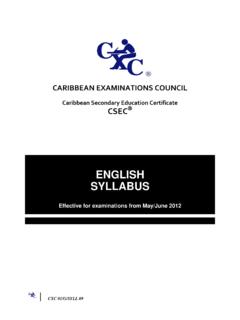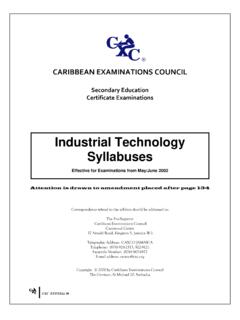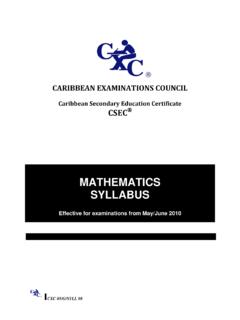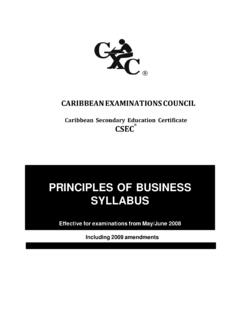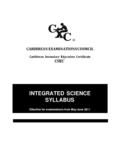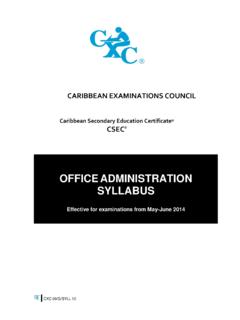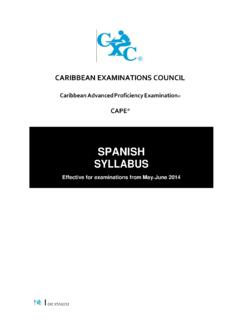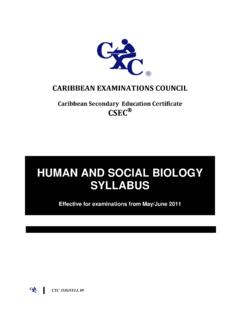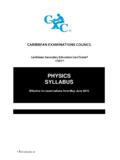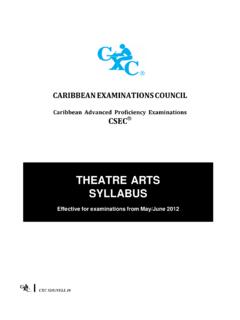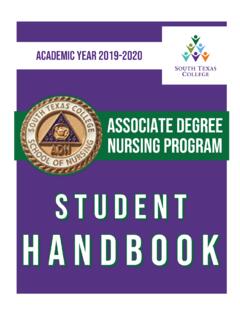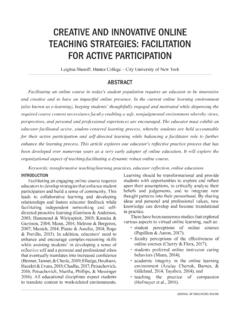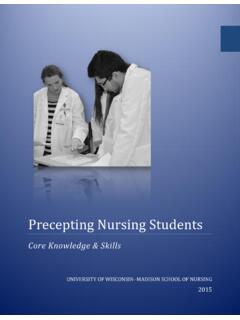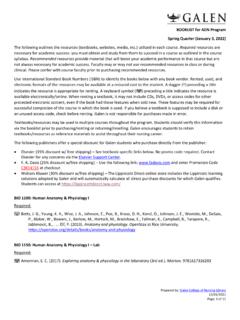Transcription of INTEGRATED SCIENCE SYLLABUS
1 C X C 2 3 / G / S Y L L 0 9 CARIBBEAN EXAMINATIONS COUNCIL Caribbean Secondary Education Certificate CSEC INTEGRATED SCIENCE SYLLABUS Effective fo r examinations from May/June 2011 Published by the Caribbean Examinations Council All rights reserved. No part of this publication may be re pr oduced, stored in a retrieval system, or transmitted in any form, or by any means electronic, photocopying, recording or otherwise without prior permission of the aut hor or publisher. Correspondence related to the SYLLABUS should be addressed to: The Pro- Registrar Caribbean Examinations Council Caenwood Centre 37 Arnold Road, Kingston 5, Jamaica, Telephone: (876) 630-5200 Facsimile Number: (876) 967- 4972 E-mail address: cxc Website: Copyright 2009, by Caribbean Examinations Council The Garrison, St Michael BB14038, Barba dos C X C 2 3 / G / S Y L L 0 9.
2 Contents RATIONALE .. 1 AIMS .. 2 PRE-REQUISITES OF THE SYLLABUS .. 2 ORGANIZATION OF THE SYLLABUS .. 3 CERTIFICATION AND DEFINITION OF PROFILES DIMENSIONS .. 3 FORMAT OF THE EXAMINATIONS .. 5 REGULATIONS FOR RESIT CANDIDATES .. 6 REGULATIONS FOR STUDENTS FROM PRIVATE INSTITUTIONS .. 6 SECTION A - THE ORGANISM AND ITS ENVIRONMENT UNIT I - THE CELL .. 7 UNIT II - FOOD AND NUTRITION .. 8 UNIT II I - RESPIRATION/AIR POLLUTION .. 10 UNIT IV - TRANSPORT SYSTEMS .. 11 UNIT V - EXCRETION .. 12 UNIT VI - SENSE ORGANS AND COORDINATION .. 13 UNIT VII - REPRODUCTION AND GROWTH .. 14 SECTION B - THE HOME AND WORKPLACE UNIT I - TEMPERATURE CONTROL AND VENTILATION .. 16 UNIT II - THE TERRESTRIAL ENVIRONMENT .. 18 UNIT II I - WATER AND THE AQUATIC ENVIRONMENT .. 20 UNIT IV - PESTS AND PARASITES/SANITATION .. 22 UNIT V - SAFETY HAZARDS .. 23 UNIT VI METALS AND 24 UNIT VII ACIDS, BASES AND MIXTURES.
3 26 SECTION C - ENERGY UNIT I - ELECTRICITY AND LIGHTING .. 28 UNIT II - FOSSIL FUELS AND ALTERNATIVE SOURCES OF ENERGY .. 31 UNIT II I - MACHINES AND MOVEMENT .. 32 UNIT IV - CONSERVATION OF ENERGY .. 33 UNIT V - FORCES .. 34 GUIDELINES FOR SCHOOL BASED ASSESSMENT .. 36 RESOURCES .. 45 .. 46 APPENDIX I - NOTE TO TEACHERS .. 51 APPENDICES I (A) - I(C) - SBA RECORD BOOKS .. 52 APPENDIX II - SOME GUIDELINES CONCERNING PRACTICAL WORK .. 55 APPENDIX II I - SUGGESTED CHEMICALS/MATERIALS LIST .. 56 APPENDIX IV - SUGGESTED EQUIPMENT LIST .. 58 C X C 2 3 / G / S Y L L 0 9 This document CXC 23/G/SYLL 09 replaces CXC 23/O/SYLL 00 issued in 2000. Please note that the SYLLABUS was revised and amendments are indicated by italics. Issued1983 Revised in 1993, 2000, 2009 Please ch eck the website, for updates on CXC s syllabuses. C X C 2 3 / G / S Y L L 0 9 INTEGRATED SCIENCE Syll abus RATI ONALE In our daily lives and in society at large, many of our decisions demand a knowledge of SCIENCE .
4 This knowledge is necessary for dealing satisfactorily with many of the sit ua tio ns that confront us daily in our home, at the workplace and in the wider environment. SCIENCE should, therefore, be an important part of our general education. The INTEGRATED Scie nce SYLLABUS atte mpts to meet this need. The SYLLABUS is based on three themes The Organism and Its Environment, The Home and Workplace, and Energy chosen because, they adequately reflect the common areas of human activity and experience. These themes form the unifyi ng points of the SYLLABUS which should, therefore, be seen as a coherent unit. INTEGRATED SCIENCE is a subject in its own right, encompassing topics mainly fr om Physics, Chemistry and Biology. Indeed, if such distinctions were made, other components such as Earth Sciences and Meteorology would also be recognized.
5 The CSEC INTEGRATED Scie nce SYLLABUS is designed to allow students to work individually and cooperatively, utilizing theoretical concepts of the course in interacti ve and practical acti vities. Students are expected to apply, scientific principles, investigative and problem sol ving skills, be effective in communicati ng scientific knowledge and demonstr ate an appreciation for all living or ganis ms in their environment. The Inte grate d Scie nce SYLLABUS is inte nded to contribute to the SCIENCE education needs of Caribbean secondary level st udents in the following group s: i. those whose abilities, aptit udes and choice of courses will all ow them to pursue only one SCIENCE subject, or who wish to pursue a SCIENCE course in the interest of a rounded general education; ii.
6 Those who study SCIENCE -related subjects such as Home Economics, Physical Education and Sport and Agricult ural SCIENCE , or who intend to go on to studies at the tertiary le vel, for careers in areas, such as, nursing and teaching. 1 C X C 2 3 / G / S Y L L 0 9 AIMS This SYLLABUS aims to: 1. develop scientifically and tec hnologic ally literate st udents; 2. develop the ability to apply scientific concepts and principles to everyday sit ua tio ns; 3. promote a willingness to work cooperatively with others and to persist with a task to a logical conclusion; 4. increase awareness of the importance of living in harmony with the environment; 5. encourage an appreciation of the need to preserve the natural environment; 6. develop experimental and critical thinki ng skills; 7.
7 Develop compete ncies that will enable st udents to make appropriate decisions rega rding health, safety and so me everyday life problems. PRE- REQUISITES OF THE SYLLABUS It is assumed that candidates would have studied INTEGRATED SCIENCE or its equivale nt up to the end of the first three ye ars of secondary school. CSEC Mathematics and English A or their equivalent are also strongly recommended as allied subjects to be studied. Mathematica l Requirements CSEC Mathematics pr ovides an excellent course that will support work in CSEC INTEGRATED SCIENCE . In particular, the areas below will be very useful. - The four basic operations (+, -, x, ) - Decimals - Change of subject of simple formulae - Substituting values into simple formulae - Significant figures - Means and modes - Graphs, hist ograms, charts, tables 2 C X C 2 3 / G / S Y L L 0 9 Suggest ed Time Allocation It is recommended that a minimum of five 40-minute periods per week over two academic years be allocated to the st udy of Inte grated Scie nce SYLLABUS .
8 This should incl ude at least one double period each week. At least two periods per week should be devoted to practicals. ORGANIZATION OF THE SYLLABUS The SYLLABUS is arranged in three sections sub-divi ded into specific objectives, corresponding expla natory notes and suggested practical activities. SECTION A - THE ORGANISM AND ITS ENVIRONMENT SECTION B - THE HOME AND WORKPLACE SECTION C - ENERGY The arrangement of the SYLLABUS does not necessarily represent a teaching order. Each section be gins with a statement of general objectives that along with the specific objectives, corresponding expla natory notes and suggested practical activities are indicative of the content on which the examinations will be based. However, the spe cific objectives should not be treated in isolation as they are related to general objectives and SYLLABUS aims.
9 CERTI FICATION AND DEFINITION OF PROFILES DIMENSIONS The subject will be examined for certification at the General Proficiency. In addition to the overall grade, there will be a profile report that reflects the candidate s performance of each candidate under the foll owing headings: (i) Knowle dge and Comprehension; (ii) Use of Knowle dge; (iii) Practical Skills. Knowledge and Comprehensi on (KC) The ability to: Knowle dge identif y, recall, state basic facts, concepts and princi ples; Comprehension select appropriate ideas, match and compare and cite examples of facts, concepts and princi ples in fa miliar sit uations. 3 C X C 2 3 / G / S Y L L 0 9 Use of Knowledge (UK) The ability to: Application transform data acc urately and appropriately; use common characteristics as a basis for classification; use formulae accurately; Analysis and Interpretation identify the component parts of a whole and interpret the relationships between those parts; identify casual factors and show how they interact with each other; Synthesis combi ne component parts to form a new meaningful whole; make predictions and solve pr oble ms; Evaluation make reasoned judgments and recommendations based on the value of ideas and information and their implications.
10 Pra c t i c a l Skills (P S) The ability to: Observation/Recording/ Reporti ng use the senses to perceive objects and eve nts accurately; present a written and oral report, drawing or other graphical representation which is clear, concise, accurate and pertinent to the investigation; report and recheck unexpected results; Drawing make large, clear, la belled line representations of specimens, apparatus or models; Manipulation/Measurement set up and use carefully and competently simple la boratory apparatus and measuring instruments; appropriately prepare specimens and materials for observation/investigation; Pla nning/Designing develop hypotheses and devise means of carryi ng out investiga tions to test them; plan experimental pr ocedures and operations within the time all otted in appropriate sequence of operations as a result of difficulties encountered in carryi ng out experiments or obtaining unexpected results; Analysis and Interpretation use experimental data to infer, predict and draw concl usions; identify trends and patterns; make necessary and acc urate calculations and recognize the limitations and assumptions of data.
